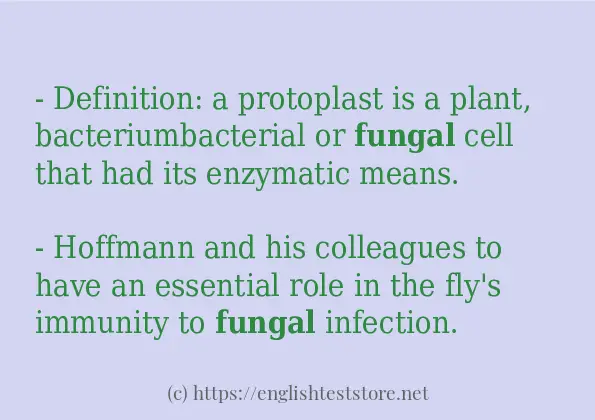How to use in-sentence of “fungal”:
– Definition: a protoplast is a plant, bacteriumbacterial or fungal cell that had its enzymatic means.
– Hoffmann and his colleagues to have an essential role in the fly’s immunity to fungal infection.
– Cow urine is used in organic farming as a fertilizer and to protect crops from fungal infections.
– Unsterilized tattoo equipment or contaminated ink could spread infections on the surface of the skin, fungal infections, some forms of hepatitis, Herpes simplexherpes simplex virus, HIV, staph, tetanus, and tuberculosis.
– The interface between the plant and fungal partners in this association is between the roots of the plant and the mycelium of the fungus.
– The fungal dimension of biodiversity: magnitude, significance and conservation.
– The fungal partners may also help plant-to-plant transfer of sugars and other nutrients.
– The fungal hyphae are more efficiencyefficient than plant roots at absorbing nutrients.

Example sentences of “fungal”:
– Six : Bark Beetle– Fungal Symbiosis: Context Dependency in Complex Associations.
– The true total number of fungal species in Chile is likely to be far higher.
– Belonging to the fungal order Phallales, the Phallaceae have a worldwide distribution, but are especially common in tropical regions.
– AF36 is a fungal antagonist and is applied as a commercial biocontrol to cotton and corn to reduce aflatoxin exposure.
– This frog does not get very sick from the chytridiomycosis fungal disease the way many other frogs do.
– The term “saprophyte” refers specifically to fungal and bacterial saprotrophs; animal saprotrophs are known as saprozoites.
– Mycorrhizal fungi may host bacteria that complete their life cycles within fungal cells.
- Six : Bark Beetle– Fungal Symbiosis: Context Dependency in Complex Associations.
- The true total number of fungal species in Chile is likely to be far higher.
- Belonging to the fungal order Phallales, the Phallaceae have a worldwide distribution, but are especially common in tropical regions.
– After dispersal by wind, such fungal spores must meet with an algal partner to form a lichen.
– They live in the soil, and eat fungal hyphae, spores, pollen and other organic material.
– The symptomatic “dumb-bell”-shaped bite marks on either side of the leaf vein on a fossilised leaf have been identified as the death-grip of a carpenter ant terminally parasitized by a fungus that, apparently then as today, took over its behaviour to release its spores at a good location; it is the earliest clear example of fungal behavioural manipulation.
– It is thought, from the number of fungal and algal species involved, that the symbiosis must have taken place many times between different species.
